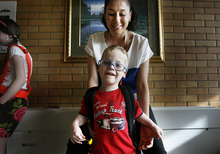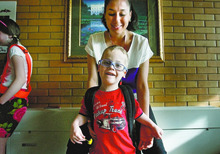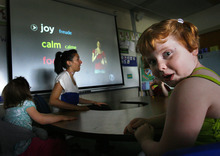This is an archived article that was published on sltrib.com in 2012, and information in the article may be outdated. It is provided only for personal research purposes and may not be reprinted.
When Gale Brown senses the students in her class need a moment to refocus, she calls a two-minute timeout.
The Eisenhower Middle School special education teacher turns to a DVD that captivates the students and hits the reset button on the day.
"It really calms them down," Brown said. "One little boy actually doesn't pay attention to anything, but he does all the moves on the video. I think it helps the kids, too, with their eye-hand coordination. Especially my kids."
MeMoves is a program created by Roberta Schref that uses music, images and movement to create a spa-like environment.
Originally intended as a program specifically for autistic and special-needs children – Schref's daughter has autism – teachers and therapists have found MeMoves to be effective in mainstream classrooms as well.
"From a therapeutic standpoint, I look at a lot of programs that help with self-regulation," said Debbie Ofenloch, an occupational therapist in the Granite School District. "It's a short, sweet little thing that seems to help the kids focus in and be more receptive and stay focused on whatever they are supposed to be learning a little bit longer."
The program consists of 13 different videos, each about two minutes long, in three different categories – calm, focus and joy.
In the videos, people of all ages and races perform a series of hand gestures that students are encouraged to mimic. Circles, vertical lines, figures eights – motions that entertain and entrance students, making the distractions of the day disappear.
"It's about putting the nervous system in a calm but alert state," Schref said. "You can't learn if you're in a completely stressed state. It engages you fully and quickly. The physical, emotional, cognitive – all that stuff gets filled up … allows them to act and respond absolutely appropriately to the world around them."
Jesse Solorzino, a developmental kindergarten teacher at Upland Terrace Elementary uses the DVD several times a week as a way to refocus her students.
She first received the program on a trial basis and, after returning her copy, now borrows Ofenloch's DVD.
"I love it," Solorzino said. "It makes a short-term change. On the days that we use it, I can definitely tell a difference. When we start it out in the morning, the rest of the day, or at least the next hour, is calm."
She also uses it just before school ends, to settle her students before they line up to walk out together.
Schref said the program is in more than 800 school districts and 12 countries. The program also is being utilized in hospitals and clinics for mental health wellness.
Schref's company, ThinkingMoves, also has developed a program for adults, which is being used for patients who suffer from Alzheimer's and dementia, as well as cardiac rehabilitation patients.
"The best way to think of it really is as a transitional tool or priming activity," Schref said. "What we find is when [people] do a sequence, whatever follows is easier and more effective."
Schools throughout the Granite School District are using the program to help students regain their focus and eliminate distractions.
The two-minute videos combine colors, music and movement that fill the students' senses and captivate their attention.
Intended for special needs students, the program has been found to be effective in mainstream classrooms as well.











